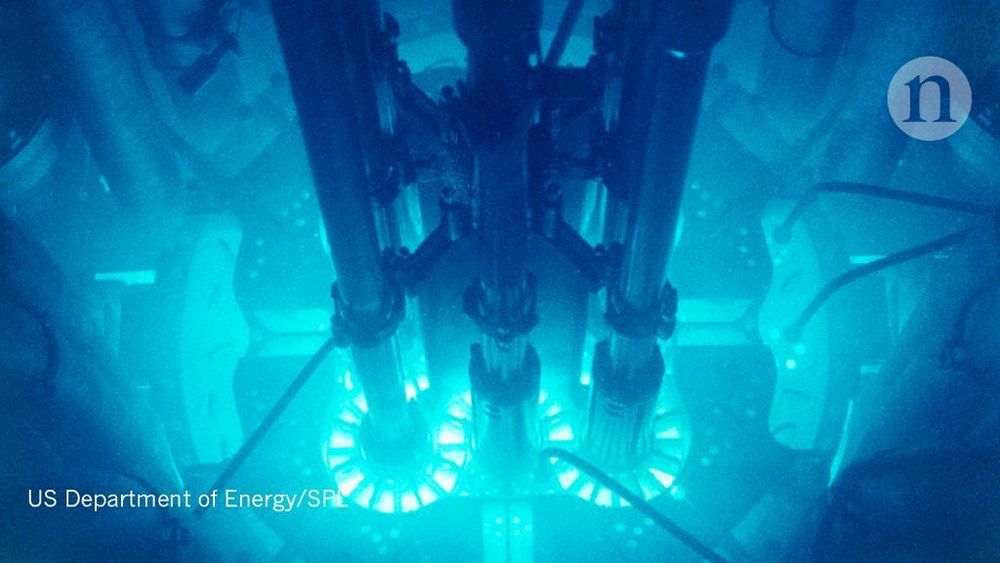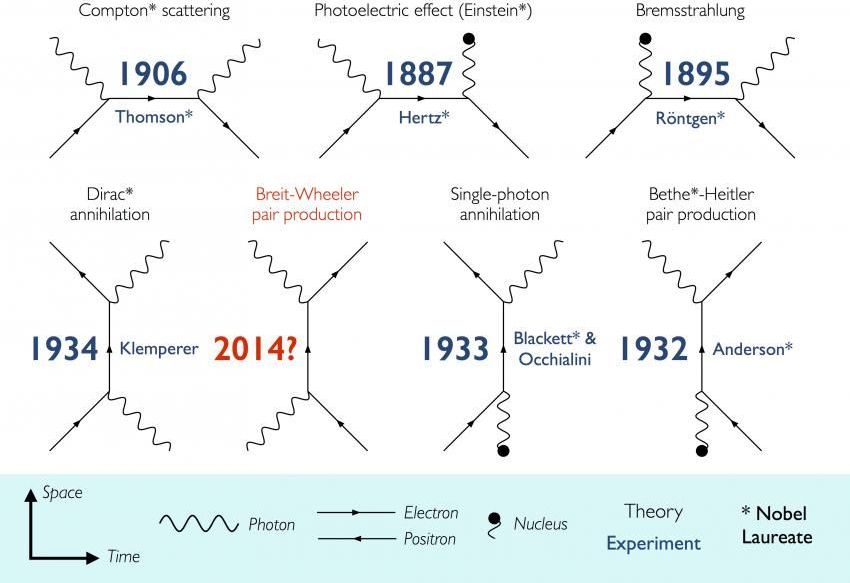Thanks to a quirk of quantum theory, subatomic particles can emit light as they travel through a seemingly empty vacuum.
Blue-tinged Cherenkov radiation could help to illuminate quantum interactions between light and matter.


Antimatter isn’t just made of antiparticles, it’s also made of waves. Now we know that this holds true even at the level of a single antimatter particle.
Physicists have known for a long time that just about everything — light and other forms of energy, but also every atom in your body — exists as both particles and waves, a concept known as particle-wave duality. That’s been shown again and again in experiments. But antimatter particles, which are identical to their matter partners, except for their opposite charge and spin, are much more difficult to experiment with. These twins of matter flit into existence fleetingly, usually in massive particle accelerators.
But now, physicists have shown at the level of a single positron — an antimatter twin of the electron — that antimatter, too, is made of both particles and waves.

Over at Picatinny Arsenal, the research and development facility and proving ground for the U.S. Army’s weaponry, engineers are developing a device that shoots lighting bolts along a laser beam to annihilate its target. That’s right: lighting bolts shot down laser beams. This story could easily end right here and still be the coolest thing we’ve written today, but for the scientifically curious we’ll continue.
The Laser-Induced Plasma Channel (LIPC) can be used to destroy anything that conducts electricity better than the air or ground surrounding it (unexploded ordnance seems a good candidate here). It works off of some pretty basic principles of physics, using a laser to carve an electromagnetic path through the air that accommodates a high-voltage beam. Create that path, crank up the voltage, and your target is toast.
It works like this: a high intensity, super-short duration (maybe two-trillionths of a second) laser pulse will actually use air like lens—surrounding air focuses the beam, keeping the laser pulse nice and tight rather than scattering it. If the pulse is strong enough, it actually creates an electromagnetic field around itself that’s so powerful it strips electrons from air molecules, essentially creating a channel of plasma through the air. Since air is composed of neutral particles (that act as insulators) and the plasma channel is a good conductor (relative to the un-ionized air around it) the path of the laser beam becomes a kind of filament.

2014 Basically a real replicator could be possible with this discovery.
Imperial College London physicists have discovered how to create matter from light — a feat thought impossible when the idea was first theorised 80 years ago.
In just one day over several cups of coffee in a tiny office in Imperial’s Blackett Physics Laboratory, three physicists worked out a relatively simple way to physically prove a theory first devised by scientists Breit and Wheeler in 1934.
Breit and Wheeler suggested that it should be possible to turn light into matter by smashing together only two particles of light (photons), to create an electron and a positron – the simplest method of turning light into matter ever predicted. The calculation was found to be theoretically sound but Breit and Wheeler said that they never expected anybody to physically demonstrate their prediction. It has never been observed in the laboratory and past experiments to test it have required the addition of massive high-energy particles.

2015
After an oil spill, the number one priority is finding a way to contain and remove the oil. Boat operators sometimes deploy physical booms to trap the oil so that it can be siphoned or burned off of the water’s surface. But, because oil in water is tricky to contain, other methods for corraling it call for adding manmade chemicals to the water.
In a technique called dispersion, chemicals and wave action break down the oil into smaller particles, which then disperse and slowly biodegrade over a large area. Then, there is chemical herding. To clean up an oil spill with a chemical herder, crews spray a compound around the perimeter of the spill. The compound stays on the surface and causes the oil to thicken. Once it’s thick enough, it can be burned off. Chemical herding requires calm water, which makes it unreliable in some spills, but, unlike mechanical removal or dispersion, it gets all the oil. The technique has been around since the 1970s, but, until now, the chemicals used to herd the oil, called soap surfectants, didn’t break down over time. After the oil burned off, they’d still be in the ecosystem.
Researchers at the City College of New York, led by chemist George John and chemical engineer Charles Maldarelli, have developed a way to clean up oil using a chemical herder made of phytol, a molecule in chlorophyll that makes algae green.
It’s the first non-toxic, natural way to remediate oil spills.

Matter waves constitute a crucial feature of quantum mechanics, in which particles have wave properties in addition to particle characteristics. This wave-particle duality was postulated in 1924 by the French physicist Louis de Broglie. The existence of the wave property of matter has been successfully demonstrated in a number of experiments with electrons and neutrons, as well as with more complex matter, up to large molecules.
For antimatter, the wave-particle duality has also been proven through diffraction experiments. However, researchers of the QUPLAS collaboration have now established wave behavior in a single positron (antiparticle to the electron) interference experiment. The results are reported in Science Advances.
The QUPLAS scientific collaboration includes researchers from the University of Bern and from the University and Politecnico of Milano. To demonstrate the wave duality of single positrons, they performed measurements with a setup similar to the so-called double-slit experiment. This setup was suggested by physicists including Albert Einstein and Richard Feynman; it is often used in quantum theory to demonstrate the wave nature of particles.


A photodetector converts light into an electrical signal, causing the light to be lost. Researchers led by Tracy Northup at the University of Innsbruck have now built a quantum sensor that can measure light particles non-destructively. It can be used to further investigate the quantum properties of light.
Physicist Tracy Northup is currently researching the development of quantum internet at the University of Innsbruck. The American citizen builds interfaces with which quantum information can be transferred from matter to light and vice versa. Over such interfaces, it is anticipated that quantum computers all over the world will be able to communicate with each other via fiber optic lines in the future. In their research, Northup and her team at the Department of Experimental Physics have now demonstrated a method with which visible light can be measured non-destructively. The development follows the work of Serge Haroche, who characterized the quantum properties of microwave fields with the help of neutral atoms in the 1990s and was awarded the Nobel Prize in Physics in 2012.
In work led by postdoc Moonjoo Lee and Ph.D. student Konstantin Friebe, the researchers place an ionized calcium atom between two hollow mirrors through which visible laser light is guided. “The ion has only a weak influence on the light,” explains Tracy Northup. “Quantum measurements of the ion allow us to make statistical predictions about the number of light particles in the chamber.” The physicists were supported in their interpretation of the measurement results by the research group led by Helmut Ritsch, a Innsbruck quantum optician from the Department of Theoretical Physics. “One can speak in this context of a quantum sensor for light particles”, sums up Northup, who has held an Ingeborg Hochmair professorship at the University of Innsbruck since 2017. One application of the new method would be to generate special tailored light fields by feeding the measurement results back into the system via a feedback loop, thus establishing the desired states.
Quantum communication is a strange beast, but one of the weirdest proposed forms of it is called counterfactual communication — a type of quantum communication where no particles travel between two recipients.
Theoretical physicists have long proposed that such a form of communication would be possible, but in 2017, for the first time, researchers were able to experimentally achieve it — transferring a black and white bitmap image from one location to another without sending any physical particles.
If that sounds a little too out-there for you, don’t worry, this is quantum mechanics, after all. It’s meant to be complicated. But once you break it down, counterfactual quantum communication actually isn’t as bizarre as it sounds.

Scientists around the world are testing ways to further boost the power of particle accelerators while drastically shrinking their size.
10/18/18
Our best model of particle physics explains only about 5 percent of the universe.
09/25/18
Particle physicists and astrophysicists employ a variety of tools to avoid erroneous results.